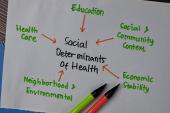Optimal Care Reported in Less Than Half of Adults With ASCVD
With racial and ethnic disparities persisting over two decades, interventions are needed to improve care across the board.

Not only have racial and ethnic differences persisted in the use of guideline-recommended therapies among adults with atherosclerotic cardiovascular disease (ASCVD) over the last 20 years, but also the overall disparity between those receiving optimal and subpar care has grown even more drastic, according to a cross-sectional study of national data.
Specifically, between 2017 and 2020, only 47.4%, 48.7%, and 53.0% of Black, Hispanic and Latino, and white adults included in the study, respectively, received guideline-recommended care.
The findings are especially surprising and discouraging given the breadth of resources dedicated to improving ASCVD care in the United States, lead author Yuan Lu, ScD (Yale New Haven Hospital, CT), told TCTMD. “Despite all this investment in the country, less than half of these patients actually receive the optimal therapy recommended by guidelines,” she said. “The gap between the current status quo with the ideal scenario is actually much larger than the racial/ethnic difference.”
Commenting on the findings for TCTMD, Joshua Bundy, PhD, MPH (Tulane University School of Public Health and Tropical Medicine, New Orleans, LA), agreed that the low rate of optimal care shown in the study is “abysmal.” But what the paper has really highlighted is how these disparities don’t exist in a silo, he said. “The political aspect of all this is, I think, sometimes overblown in the sense that it's not really a zero-sum game where we are just looking at addressing disparities. You can address disparities and improve the health of all people at the same time if you just start to target some of these structural issues, like make sure it is possible for everyone to have access to care, for instance.”
With such a complicated problem, it’s time to move on to interventions that will increase the proportion of people receiving optimal care, Bundy added. “If you improve that, you are going to simultaneously address health disparities and also just improve health for everyone.”
The findings were published online last week in JAMA Network Open.
20 Years of Data
For the study, Lu and colleagues analyzed data on 5,218 adults with ASCVD (mean age 65.5 years; 44.2% women) from the National Health and Nutrition Examination Survey (NHANES) between 1999 and 2020, including 11.6% who were Black, 7.7% Hispanic or Latino, and 80.7% white.
Over the two decades of the study, total cholesterol control and lipid-lowering medication use significantly increased in all racial and ethnic subgroups. However, Black and Hispanic/Latino adults were less likely to be treated with lipid-lowering medications than white adults in both 1994-2004 and 2017-2020. There were no improvements across all racial and ethnic groups in use of blood pressure-lowering medications, and white adults were the only group to see a trend toward greater control of blood pressure over time. Similarly, only white patients were treated with significantly more blood glucose-lowering medications over the study period, while none of the racial or ethnic groups saw any significant improvement in control of blood glucose.
Use of statins improved by 22.3%, 24.8%, and 25.5% percentage points for Black, Hispanic and Latino, and white patients over the study period. Use of ACE inhibitors and ARBs increased both among Hispanic and Latino and white individuals, by 17.1% and 12.1%, respectively.
Smoking cessation also improved within the Hispanic and Latino population, rising an absolute 27.1% over the entire study period. This, in turn, resulted in a relative 24.9% improvement in smoking cessation for these patients as compared with white patients between 2017 and 2020 (P < .001). Obesity significantly increased in only white patients, who had a 12.1% decrease in prevalence (P = 0.003).
The mechanisms at play here are multifactorial, Lu said. “Clinical inertia” has likely driven physicians to avoid updating their practice as new therapies become endorsed by guidelines, whereas “low health literacy,” financial burden, and other social determinants of health are likely barriers to patients, she said.
Interventions Need Implementation
Awareness is the first step toward change, she said. “Now that we notice at the national level that there is a significant gap between the ideal scenario and the current status quo, . . . the doctors, patients, and policy makers should be aware of it,” Lu said, adding that a “multilevel intervention [is needed to address] factors at both the provider level and patient level.”
One example, she said, would be a clinical decision support tool that could automatically embed within the electronic health record to help streamline physician workload. “A screen can pop up when the doctor sees the patient and provide recommendations to the doctor: ‘These are the recommended drugs to be prescribed based on this patient's profile.’ And then the doctor can just click several buttons and then finish the prescription.”
Lu said the field has an “implementation science issue.”
“What we lack is not the intervention itself, but the strategy to make sure these interventions are implemented in practice,” she explained.
Even though the NHANES data show that care is suboptimal across all patient groups and should encourage improvements across the board, Lu said special attention should be paid “to these racial and ethnic minorities who are currently doing worse than their white counterparts.”
Bundy, too, said he would like to see more novel approaches, especially those targeting social determinants of the health. “My research group is guilty of this, as well, where we keep publishing these papers where we are showing that there are these not just racial and ethnic disparities, but also socioeconomic disparities,” he said. “We are implicating the social determinants of health and structural factors, and yet there are not as many interventions that are really able to address these things.”
This is changing, however, he said, citing an ongoing program sponsored by the National Institutes of Health seeking interventions that specifically target social determinants of health. “These are things that are going to help everyone,” Bundy said. “We know that control is important and, in general, we know of a lot of the factors that go into risk factor control, but we need to figure out what the best evidence-based practices are for realizing that improvement in control.”
Additionally, Bundy highlighted, it can be easy to get excited about new medications and treatment approaches, but the data make one thing very clear—better implementation of existing treatments continues to lag. “I think new treatment approaches are always going to be of interest, [and it’s] important to keep evolving that, but in general, we need to do better with what we have,” he commented.
Yael L. Maxwell is Senior Medical Journalist for TCTMD and Section Editor of TCTMD's Fellows Forum. She served as the inaugural…
Read Full BioSources
Lu Y, Liu Y, Dhingra LS, et al. National trends in racial and ethnic disparities in use of recommended therapies in adults with atherosclerotic cardiovascular disease, 1999-2020. JAMA Network Open. 2023;6(12):e2345964.
Disclosures
- Lu and Bundy report no relevant conflicts of interest.





Comments